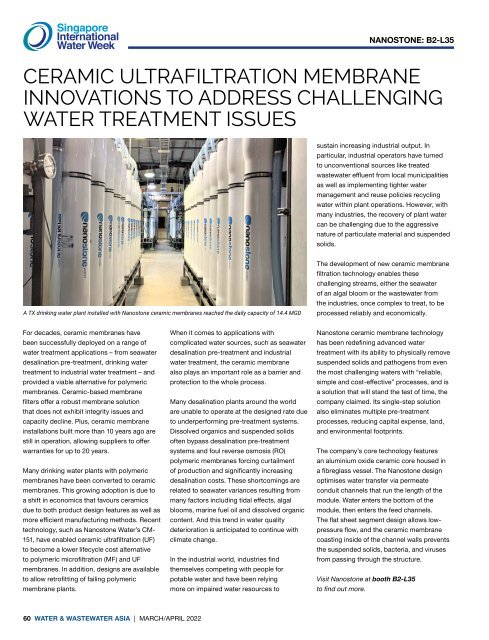Water & Wastewater Asia March/April 2022
Water & Wastewater Asia is an expert source of industry information, cementing its position as an indispensable tool for trade professionals in the water and wastewater industry. As the most reliable publication in the region, industry experts turn this premium journal for credible journalism and exclusive insight provided by fellow industry professionals. Water & Wastewater Asia incorporates the official newsletter of the Singapore Water Association (SWA).
Water & Wastewater Asia is an expert source of industry information, cementing its position as an indispensable tool for trade professionals in the water and wastewater industry. As the most reliable publication in the region, industry experts turn this premium journal for credible journalism and exclusive insight provided by fellow industry professionals. Water & Wastewater Asia incorporates the official newsletter of the Singapore Water Association (SWA).
Create successful ePaper yourself
Turn your PDF publications into a flip-book with our unique Google optimized e-Paper software.
NANOSTONE: B2-L35<br />
CERAMIC ULTRAFILTRATION MEMBRANE<br />
INNOVATIONS TO ADDRESS CHALLENGING<br />
WATER TREATMENT ISSUES<br />
sustain increasing industrial output. In<br />
particular, industrial operators have turned<br />
to unconventional sources like treated<br />
wastewater effluent from local municipalities<br />
as well as implementing tighter water<br />
management and reuse policies recycling<br />
water within plant operations. However, with<br />
many industries, the recovery of plant water<br />
can be challenging due to the aggressive<br />
nature of particulate material and suspended<br />
solids.<br />
A TX drinking water plant installed with Nanostone ceramic membranes reached the daily capacity of 14.4 MGD<br />
The development of new ceramic membrane<br />
filtration technology enables these<br />
challenging streams, either the seawater<br />
of an algal bloom or the wastewater from<br />
the industries, once complex to treat, to be<br />
processed reliably and economically.<br />
For decades, ceramic membranes have<br />
been successfully deployed on a range of<br />
water treatment applications – from seawater<br />
desalination pre-treatment, drinking water<br />
treatment to industrial water treatment – and<br />
provided a viable alternative for polymeric<br />
membranes. Ceramic-based membrane<br />
filters offer a robust membrane solution<br />
that does not exhibit integrity issues and<br />
capacity decline. Plus, ceramic membrane<br />
installations built more than 10 years ago are<br />
still in operation, allowing suppliers to offer<br />
warranties for up to 20 years.<br />
Many drinking water plants with polymeric<br />
membranes have been converted to ceramic<br />
membranes. This growing adoption is due to<br />
a shift in economics that favours ceramics<br />
due to both product design features as well as<br />
more efficient manufacturing methods. Recent<br />
technology, such as Nanostone <strong>Water</strong>’s CM-<br />
151, have enabled ceramic ultrafiltration (UF)<br />
to become a lower lifecycle cost alternative<br />
to polymeric microfiltration (MF) and UF<br />
membranes. In addition, designs are available<br />
to allow retrofitting of failing polymeric<br />
membrane plants.<br />
When it comes to applications with<br />
complicated water sources, such as seawater<br />
desalination pre-treatment and industrial<br />
water treatment, the ceramic membrane<br />
also plays an important role as a barrier and<br />
protection to the whole process.<br />
Many desalination plants around the world<br />
are unable to operate at the designed rate due<br />
to underperforming pre-treatment systems.<br />
Dissolved organics and suspended solids<br />
often bypass desalination pre-treatment<br />
systems and foul reverse osmosis (RO)<br />
polymeric membranes forcing curtailment<br />
of production and significantly increasing<br />
desalination costs. These shortcomings are<br />
related to seawater variances resulting from<br />
many factors including tidal effects, algal<br />
blooms, marine fuel oil and dissolved organic<br />
content. And this trend in water quality<br />
deterioration is anticipated to continue with<br />
climate change.<br />
In the industrial world, industries find<br />
themselves competing with people for<br />
potable water and have been relying<br />
more on impaired water resources to<br />
Nanostone ceramic membrane technology<br />
has been redefining advanced water<br />
treatment with its ability to physically remove<br />
suspended solids and pathogens from even<br />
the most challenging waters with “reliable,<br />
simple and cost-effective” processes, and is<br />
a solution that will stand the test of time, the<br />
company claimed. Its single-step solution<br />
also eliminates multiple pre-treatment<br />
processes, reducing capital expense, land,<br />
and environmental footprints.<br />
The company’s core technology features<br />
an aluminium oxide ceramic core housed in<br />
a fibreglass vessel. The Nanostone design<br />
optimises water transfer via permeate<br />
conduit channels that run the length of the<br />
module. <strong>Water</strong> enters the bottom of the<br />
module, then enters the feed channels.<br />
The flat sheet segment design allows lowpressure<br />
flow, and the ceramic membrane<br />
coasting inside of the channel walls prevents<br />
the suspended solids, bacteria, and viruses<br />
from passing through the structure.<br />
Visit Nanostone at booth B2-L35<br />
to find out more.<br />
60 WATER & WASTEWATER ASIA | MARCH/APRIL <strong>2022</strong>


















